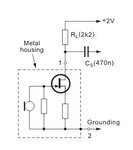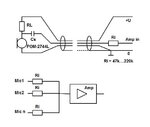Bronston
Newbie level 3
This is a bit out of my realm so forgive me if I don't seem particularly knowledgeable on the topic, it's only because I'm not. I have a system that controls most of the electrical devices in my home. The devices themselves are directly controlled by a atmega644p which is in turn controlled by my computer. I have software I've constructed in java that uses sphinx 4 to receive voice commands. Sorry long winded description, seemed necessary though. This all works perfectly except for one hitch. I need to have my stupid pc headset on in order to use the voice control system. This is obviously very limiting. My solution is to build an array of condenser mics to pick up my voice anywhere all through the simple little 1/8" jack on my computer. I have attempted this already but the mics where either not sensitive enough or too sensitive and all I got was garbage. I have run across an amplifier circuit that seems like it maybe the right direction but I, as I said, am sadly understudied in this arena. If I could get some solid direction it would probably make this entire project much more doable.
Here's the mics I have/would like to use.
Condenser Mics x 10
Mouser Part #: 665-POM-2744L
Manufacturer Part #: POM-2744L
Data Sheet: https://www.puiaudio.com/pdf/POM-2744L.pdf
I have some amplifier transistors I've robbed out of a couple surround sound head units as well, though their location escapes me at the moment. Just generally is there any chance of these being of any use?
Here's the circuit I was looking at. Is it along the right lines or not? If so would I put it at the end of the array or would I need one at every mic?

Thank you **broken link removed**.
Here's the mics I have/would like to use.
Condenser Mics x 10
Mouser Part #: 665-POM-2744L
Manufacturer Part #: POM-2744L
Data Sheet: https://www.puiaudio.com/pdf/POM-2744L.pdf
I have some amplifier transistors I've robbed out of a couple surround sound head units as well, though their location escapes me at the moment. Just generally is there any chance of these being of any use?
Here's the circuit I was looking at. Is it along the right lines or not? If so would I put it at the end of the array or would I need one at every mic?

Thank you **broken link removed**.




